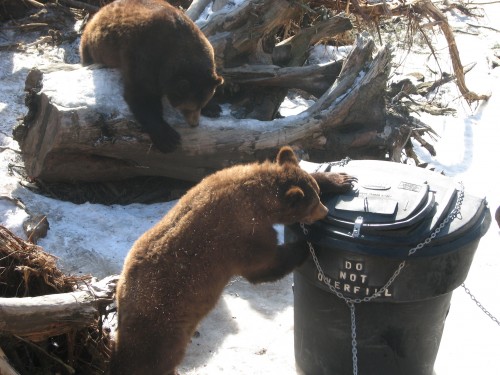
Haines residents saw an increase in bear activity around town this fall. In response, the Haines Borough set up a task force to address bear-related issues. The group met for the first time on Jan. 21 to discuss how to prevent bears from causing damage to property and danger to residents.
According to Haines Borough Police Chief Heath Scott, the department received 182 bear-related calls in 2019. That is more than double the number of bear-related calls they received the previous year.
Most of the reports of bear activity came during September and October. Alaska Department of Fish and Game wildlife management biologist Carl Koch estimated there were 12 to 15 bears roaming the Haines townsite this fall. He said they caused a lot of damage.
“You couldn’t imagine how many dumpsters were flipped. Ten to 15 dumpsters,” Koch said.
That’s why the borough put together a task force of stakeholders from different Haines organizations to tackle the issue.
There are a few different theories about what caused the spike in bear activity in town this fall. Fish and Game bear biologist Anthony Crupi said the bears’ diet is one consideration.
“With really low returns of pink salmon and coho salmon this year, bears are really searching out any opportunities they can find,” he said.
Crupi has been tracking bears in the Chilkat Valley for a population study.
He noticed that bears spent most of the summer gorging on berries up in the mountains rather than fishing, which may be related to the low pink salmon run.
That is not to say there were no fish for the bears to eat. The sockeye salmon run on the Chilkoot River was the largest return since Fish and Game started collecting data there in the 1970s.
At the meeting, Koch said the timing of the runs affects the bears’ ability to fish.
“It’s how many fish, but it’s also when they’re coming through,” Koch said. “A bear can only catch so many fish a day. If a huge pulse comes through over two days, they’re going to miss a lot of those, and then it slows right down the rest of the season. They’re going to look for something else.”
Changes in waste management in Haines are another possible reason for more bear activity. Craig Franke recently became the general manager of Community Waste Solutions, and since he started managing the waste facility in August, staff have been working to cover exposed garbage and have placed an electric fence around part of the property.
Haines resident Donnie Turner III said he noticed more bears around his home after those improvements were made.
“I bet you look at your records from when he came here and started doing his job, fencing the dump off, those bears pushed into town,” Turner said.
However, Crupi said he saw just as many bears at the dump in 2018 as there were last year.
The task force did identify weak dumpsters as a significant problem. At the meeting, Franke said CWS will begin retrofitting or replacing dumpsters that are not bear-proof.
In addition to securing “attractants,” some members of the task force wanted to address problem bears more directly. Alaska State Parks Ranger Travis Russell said some bears are starting to use garbage as a food source.
“We do have bears in town that are habituated to garbage, and they’re teaching their cubs to do the same,” Russel said. “So, that’s the point that we do need to look at hazing or eliminating those bears.”
Koch said there are non-lethal options for intervening to change bears’ behavior.
“There’s hazing and aversive conditioning. Hazing is just whaling away to get the bear to go away. Aversive conditioning is trying to catch the bear in the act, getting the bear to understand, ‘Oh, this is because of the garbage can.’ That’s a lot trickier to do,” Koch said.
Scott said the increase in bear activity around town isn’t just a concern in terms of property damage.
Last year, he considered killing a large bear that was seen walking around the Haines School just as students were arriving for class. Police were able to chase the bear towards the fairgrounds, but they were concerned about taking a shot at it near someone’s home.
Deciding whether to kill a bear is a decision that involves input from multiple agencies, and there is no set criteria to determine when it’s appropriate. Any police officer is allowed to make that call, and Scott said that’s the way it should be. He said there needs to be a clearer procedure.
“If we have bears that return consistently and go from nuisance to public safety, I think we should have a strategy for how we euthanize that animal humanely,” Scott said.
The task force decided to come up with requirements for a perimeter to deter bears from the landfill. The group will meet again Feb. 7.
